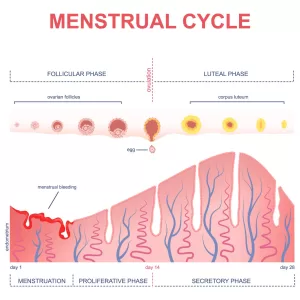Explaining Short Luteal

A short luteal phase lasts 8 days or less. The hormone progesterone is essential to implantation and a successful pregnancy. Because of this, a short luteal phase may contribute to infertility.
When a short luteal phase occurs, the body doesn’t produce enough progesterone, so the uterine lining doesn’t properly develop. This makes it difficult for a fertilised egg to implant in the uterus.
If you do become pregnant after ovulation, a short luteal phase may result in an early miscarriage. To sustain a healthy pregnancy, the uterine lining must be thick enough for an embryo to attach itself and develop into a baby.
A short luteal phase can also be due to the failure of the corpus luteum.
If the corpus luteum doesn’t secrete enough progesterone, your uterine lining may shed before a fertilized egg implants. This can cause an earlier menstrual cycle.
LPD can also be caused by certain conditions, such as:
- endometriosis, a condition where tissue normally found inside the uterus starts to grow outside the uterus
- polycystic ovarian syndrome (PCOS), a disorder that causes enlarged ovaries with small cysts
- thyroid disorders, such as an overactive or an underactive thyroid, Hashimoto’s thyroiditis, and iodine deficiency
- obesity
- anorexia
- excessive exercise
- aging
- stress
Symptoms of a short luteal phase
If you have a short luteal phase, you may not realize there’s a problem. In fact, you might not suspect fertility issues until you’re unable to conceive.
If you’re having difficulty getting pregnant, your doctor can investigate further to see if you have LPD. Symptoms may include:
- earlier than normal menstrual cycles
- spotting in between periods
- inability to get pregnant
- miscarriage
Diagnosing short luteal phase
If you can’t get pregnant, figuring out the underlying cause is the first step to improving your odds of conception. Talk to your doctor about infertility.
They can conduct a variety of tests to determine whether infertility is caused by a short luteal phase or another condition. You’ll likely have blood tests to check your levels of the following hormones:
- follicle-stimulating hormone (FSH), a hormone released by the pituitary gland that regulates ovary function
- luteinizing hormone, the hormone that triggers ovulation
- progesterone, the hormone that stimulates the growth of the uterine lining
In addition, your doctor may recommend an endometrial biopsy.
During the biopsy, a small sample of your uterine lining is collected and examined under a microscope. Your doctor can check the thickness of the lining.
They may also order a pelvic ultrasound to examine the thickness of your uterine lining. A pelvic ultrasound is an imaging test that uses sound waves to generate pictures of organs in your pelvic area, including your:
- ovaries
- uterus
- cervix
- fallopian tubes
Treatment for short luteal phase
Once your doctor identifies the underlying cause of your LPD, pregnancy may be possible. In many cases, treating the cause is key to improving fertility.
For example, if a short luteal phase results from extreme exercise or stress, decreasing your activity level and learning stress management can cause the return of a normal luteal phase.
Techniques to improve stress levels include:
- decreasing personal obligations
- deep breathing exercises
- meditation
- moderate exercise
Your doctor may also recommend supplemental human chorionic gonadotropin (HCG), which is a pregnancy hormone. Taking this supplement can help your body produce a higher level of the hormone progesterone.
Your doctor may also recommend taking additional progesterone supplements after ovulation. This helps your uterine lining grow to a point where it can support the implantation of a fertilized egg.
Other methods to increase your chance of getting pregnant include medications, such as clomiphene citrate, which stimulates your ovaries to produce more follicles and release more eggs.
Not all treatments work for every woman, so you’ll have to work closely with your doctor to find the most effective medication or supplement.






